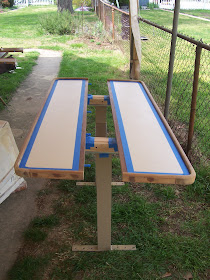We found an Ethan Allen solid cherry harvest (drop leaf) table at the local flea market, and negotiated it down to $5. At that price, we couldn’t go wrong and if nothing else, it could serve as a prototype to help us visualize what we wanted. So we took it home and went to work.
 |
| Bill removing the drop leaves |
We also decided that we wanted the table to run parallel to the seating area rather than the center line of the boat. Not the most traditional look but aesthetically it looked better to us and it strategically moved the corner of the table away from the companionway ladder base (to help avoid any potential accidents when coming down the steep ladder). And the table base needed to be very strong and sturdy, yet light at the same time (in case we needed to move it to get to the tanks under the floor boards).
Since the seating is on an angle, we decided to make the table more of a parallelogram than a traditional rectangle. I mean, why make the project easy? And we determined that two leaves would give us the flexibility we wanted for entertaining, sewing, laying out charts, etc.
After putting the bargain table in place to check the fit and take measurements, Bill started to part out the table. He removed the leaves and table base and then decided we could use the remaining tabletop in our design. He cut the ends on an angle to match the seating area, rounded the corners, and then cut the table in half lengthwise. I laminated almond colored Formica to the two pieces, while he planed some teak boards to trim the inner edge. The trim pieces were affixed with epoxy and stainless nails.
 |
| Never can have enough clamps! |
 |
| Table base and sliders |
 |
| Close up of the backing plates |
 |
| Ready for leaves and trim edges! |
 |
| Leaves cut to length |
 |
| Hardware's installed and getting ready for poly |
After taping off and applying several coats of polyurethane to the teak, the table was finally ready for install. We carried the table down to the boat, determined the desired placement and through bolted the table and backing plates to the cabin sole.
 |
| All taped off |
 |
| Table without leaves |
 |
| 1 leaf option, and slid towards the seating area |
 |
| Both leaves in place and ready for party-mode! |

To me, the journey was critical and it included the 'build' process. Enjoy it all! Looks like you are doing beautiful work and will forever remember the joy and pride involved. I had always felt, while I was doing the rebuild of Memory Rose, that if I died that day, I would pass on a happy man, doing what I loved. So to you I wish the same joy.
ReplyDelete